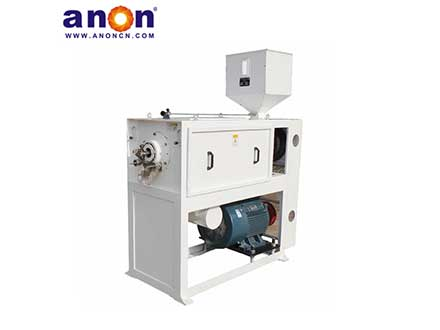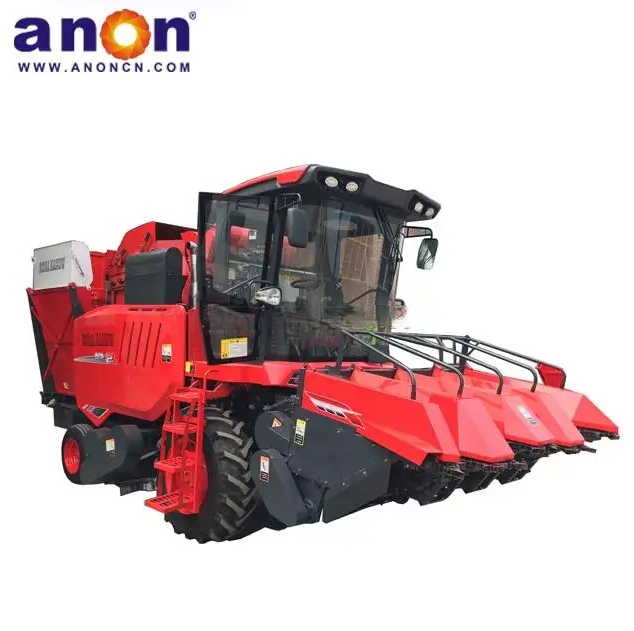Have you ever wondered how does a combine harvester work? Today, a combine harvester can complete all the harvesting work all one time. This would take several days of work in the past!
How many steps will the crops pass through until they finally become the ears of rice?
As experts in the field, we will take you through the important harvesting process in this machine. Well, ready to embark on today’s journey of learning about combine harvesters?
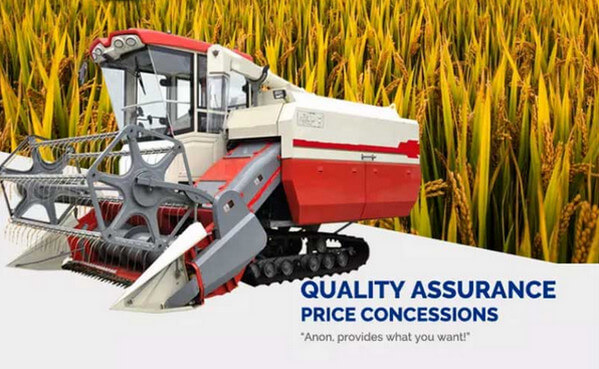
The Cutting System
Combine harvester is divided into two kinds according to feeding method. One is a full-feeding combine harvester, and the other is a semi-feeding one. The cutting system of the two is very different.
How does a Combine Harvester Work with Full-feeding Header
The cutting header of the all-feeding combine harvester is a large hollow iron frame with lots of teeth on it. When you look at it from the side, it is usually a pentagon structure. This is the picking wheel for the harvester.
The main function of the picking wheel is to press the crops in front of the wheel into the screw conveyor. The teeth on it help to feed the crop into the conveyor without missing any.
The parts with pointed edges on both sides of the frame are dividers. They help separate and evenly feed collapsed or piled crops into the machine.
For a full-feeding harvester, there is usually no need for alignment. Because its cutting width matches the machine’s body, covering the entire working width. So, when operating the full-feeding harvester, you only need to follow along the field edge.
How does a Combine Harvester Work with Semi-feeding Header
The header of a semi-feed combine harvester resembles a piano key with a concave shape.
Compared with full-feeding combine harvesters, semi-feedings usually need to be aligned during harvesting. This will ensure operational efficiency and quality of harvesting.
During the row alignment process, you need to adjust the position of the harvester. The cutting table should align the slit of the previous row, ensuring the next row can be cut smoothly.
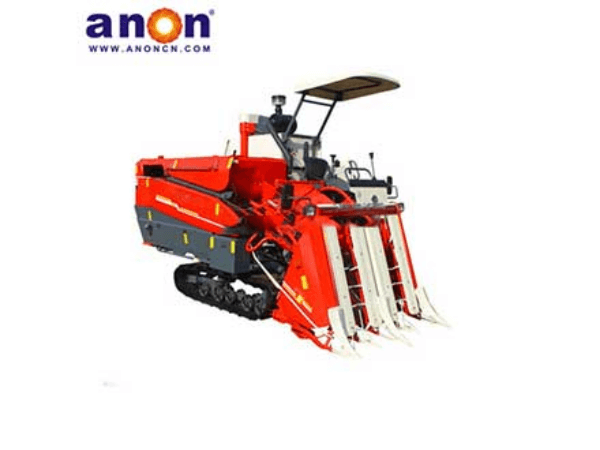
The Conveying System
The conveying system of combine harvester has three important parts. Then, how does a combine harvester work in this part?
The first one is the spinning auger, which is similar to a horizontal cylinder. Its surface is spirally arranged. Through continuous rotation, the crop cut by the cutting table is sent to the second part, the telescopic teeth. This is at the end of the screw conveyor.
The telescopic gear will transport the crops inward and adjust their direction. So that the crop will longitudinally come to the chain device. And then, transferring to the threshing drum finally.
This process enables the smooth transport and handling of the crop. Then, efficient harvesting and later treatment will be ensured.
After the above three steps, the conveying system of the combine harvester will fulfill its mission. Then, your crops will go to the next step.
The Threshing System
Generally speaking, the threshing system consists of a threshing cylinder and a threshing screen. This is where the incoming grain is separated from the stalk.
The threshing drum is the most crucial component. It looks like a metal cylinder with a raised-toothed structure. The rotating motion of the drum and the design of the toothed structure help the combine harvester to separate the grain from the stalk.
The threshing screen is located below the threshing drum. It helps to filter and separate the grain from the straw. So that the grain can pass through and the straw is left.
According to the different axial arrangements of the threshing drum, it is mainly divided into the following three types:
How does a Combine Harvester Work with Horizontal Shaft Threshing Drum
The horizontal shaft threshing drum is one of the most common types. Its drum is arranged horizontally, that is, perpendicular to the direction of travel of the harvester. This arrangement allows the grain to be separated quickly and evenly within the roller.
The cross-axis threshing drum is usually composed of a series of parallel threshing teeth. This can effectively separate the crop ear from the straw through quick rotating and continuous beating.
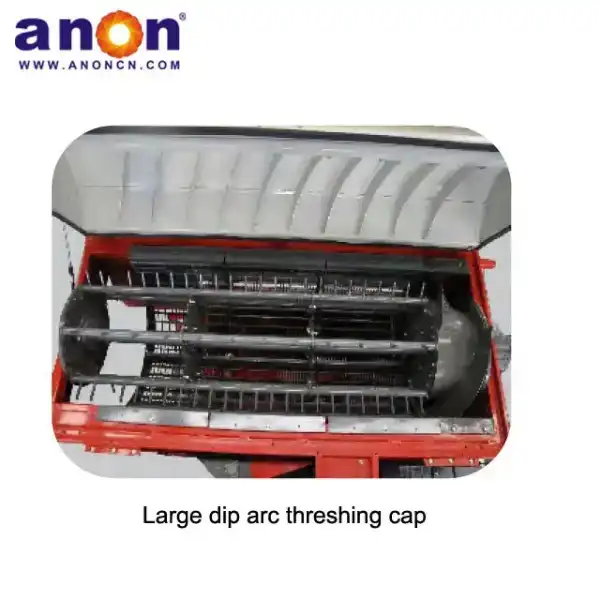
How does a Combine Harvester Work with Longitudinal Shaft Threshing Drum
The axis of the longitudinal shaft threshing drum is parallel to the direction of travel of the harvester.
This arrangement allows the grain to move along the axis of the roller, thus separating it from the straw.
The working principle of the longitudinal shaft threshing drum is similar to that of the horizontal shaft threshing drum. however, its arrangement allows the grain to move longer and hit more times in the drum. Therefore, in the case of high humidity or high yield, the longitudinal axis also performs well.
How does a Combine Harvester Work with Horizontal and Vertical Double Rollers
The horizontal and vertical double roller combines the advantages of the horizontal axis and the vertical axis. So that it is a threshing roller type with high efficiency. Because it has both kinds of drum arrangements, it can separate crops in both directions. This greatly improved the threshing efficiency and working quality of the combine harvester. You can use it in different types and conditions of harvesting operations. It has good adaptability and stability.
The Cleaning System
The cleaning system of the harvester is a vital part of the combine harvester. How does a combine harvester work in this part? Its main role is to clean, separate, and screen the grain after harvest. This part ensures the final harvest has good quality by removing impurities and non-target substances. The cleaning system consists of the following parts:
Vibrating Screening Device
This device’s main role is to separate the grain from the impurities such as straw and debris by vibrating screening. The device performs the initial cleaning and separating of the crop collected, ensuring the initial quality of the grain.
Air Separation System
How does a combine harvester work in an air separation system? The air separation system works at the same time as the vibrating screening device.
Its main role is to use the airflow to separate the grain from light impurities, such as straw fragments and debris.
By adjusting wind speed, this system removes light impurities out of the combine harvester. It is the key to improving the purity and quality of the grain.
Particle Separator
The particle separator is an important part of the cleaning system, usually located below the air separation system. Its main function is to separate the grain from larger unwanted objects such as stones and metals. How does a combine harvester work in a particle separator? The particle separator uses a screen or mesh structure to separate the grain and transfer it to the grain collection tank. Then, remove the unwanted particles to the outside of combine harvester machine.
These three parts work together to ensure that the harvested grain is of good quality and meets commercial standards.
The Storage System
After the previous four steps, the grain will come to the final step of harvesting, and storage!
The main storage equipment is the grain tank. It is usually located at the back or side of the combine harvester. So that it can effectively hold a large amount of grain within a large area.
How does a combine harvester work in the storage system? How does the grain get into the tank? Well, after finishing all the cleaning work, the gain elevator will lift all the clear crops to the collection tank for temporary storage. This will ensure the continuous operation of the harvester and improve the efficiency of the operation.
This part also plays a big role in the whole harvesting process. For example, by collecting the grain in time, you can avoid the scattering and loss of the grain. What is more, the integrity and quality of the crop are guaranteed.

Conclusion
In brief, the above are the 5 most important components of a combine harvester. We believe you will have a better understanding of how does a combine harvester work after reading this passage.
If there still exists doubts, feel free to consult ANON. We are very trustworthy and are glad to answer any questions!



